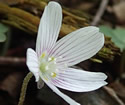Oxalis montana (Common Wood Sorrel)
| Also known as: | Mountain Woodsorrel |
|---|---|
| Genus: | Oxalis |
| Family: | Oxalidaceae (Wood Sorrel) |
| Life cycle: | perennial |
| Origin: | native |
| Habitat: | part shade, shade; rich, moist woods, wooded swamps |
| Bloom season: | May - July |
| Plant height: | 2 to 6 inches |
| Wetland Indicator Status: | none |
| MN county distribution (click map to enlarge): |  |
| National distribution (click map to enlarge): |  |
Pick an image for a larger view. See the glossary for icon descriptions.
Detailed Information
Flower: 
![[photo of flowers]](/udata/r9ndp23q/pd/oxalis-acetosella-879-10-t.jpg) Single flower, often nodding, at the tip of a slender stalk that rises slightly above the leaves. Flowers are ½ to ¾ inch across, with 5 oblong-elliptic petals slightly notched at the tip, white to pale pink with darker pink veins and a spot of yellow at the base of each petal. In the center are 10 white stamens and 5 slender white styles longer than the stamens.
Single flower, often nodding, at the tip of a slender stalk that rises slightly above the leaves. Flowers are ½ to ¾ inch across, with 5 oblong-elliptic petals slightly notched at the tip, white to pale pink with darker pink veins and a spot of yellow at the base of each petal. In the center are 10 white stamens and 5 slender white styles longer than the stamens.
![[photo of sepals]](/udata/r9ndp23q/pd/oxalis-acetosella-879-13-t.jpg) Behind the flower, alternating with the petals, are 5 narrowly lance-oblong sepals ¼ to 1/3 as long as the petals. Petal-less, self-fertile (cleistogamous) flowers are produced late in the season on drooping stalks.
Behind the flower, alternating with the petals, are 5 narrowly lance-oblong sepals ¼ to 1/3 as long as the petals. Petal-less, self-fertile (cleistogamous) flowers are produced late in the season on drooping stalks.
Leaves and stems: 


![[photo of leaves]](/udata/r9ndp23q/pd/oxalis-acetosella-8983-t.jpg) Leaves are basal, clover-like, ½ to ¾ inch across with three heart-shaped leaflets, wider than long, often folding down, sparsely covered with appressed brown hairs, the slender leaf stalks shorter than the flower stalks, and attached to a scaly, creeping, underground stem (rhizome).
Leaves are basal, clover-like, ½ to ¾ inch across with three heart-shaped leaflets, wider than long, often folding down, sparsely covered with appressed brown hairs, the slender leaf stalks shorter than the flower stalks, and attached to a scaly, creeping, underground stem (rhizome).
![[photo of stem]](/udata/r9ndp23q/pd/oxalis-acetosella-879-1-t.jpg) The flowering stem is 2 to 5½ inches long, hairy near the flower and more sparsely so below, often reddish towards the base, jointed just above the middle with two scale-like attendant bracts.
The flowering stem is 2 to 5½ inches long, hairy near the flower and more sparsely so below, often reddish towards the base, jointed just above the middle with two scale-like attendant bracts.
Fruit: 
![[photo of developing fruit]](/udata/r9ndp23q/pd/oxalis-acetosella-879-11-t.jpg) Fruit is an erect, rounded capsule, somewhat flattened with five sections, each containing 1 or 2 seeds.
Fruit is an erect, rounded capsule, somewhat flattened with five sections, each containing 1 or 2 seeds.
Notes:
Common Wood Sorrel is the least well known of our four native sorrel species. A shy delicate flower most often hidden away in cool woods and swamps in the Arrowhead, it can form large creeping colonies, spreading in and around a large area. One population we encountered however was in semi-open sandy pines at a popular wayside rest. It is easily identified by the hairy, clover-like leaves and distinctive pink and white striped flowers. The name of this species has switched back and forth between Oxalis acetosella and Oxalis montana; the latter is currently accepted.
Native Plant Nurseries, Restoration and Landscaping Services ↓
More photos
 Common Wood Sorrel plant
Common Wood Sorrel plant Common Wood Sorrel plants
Common Wood Sorrel plants Common Wood Sorrel plants
Common Wood Sorrel plants a small mat of Common Wood Sorrel
a small mat of Common Wood Sorrel
Photos by K. Chayka and Peter M. Dziuk taken in Lake County.
Comments
Have you seen this plant in Minnesota, or have any other comments about it?
on: 2016-06-30 11:19:01
Found about dozen plants flowering on 6/29/16.






